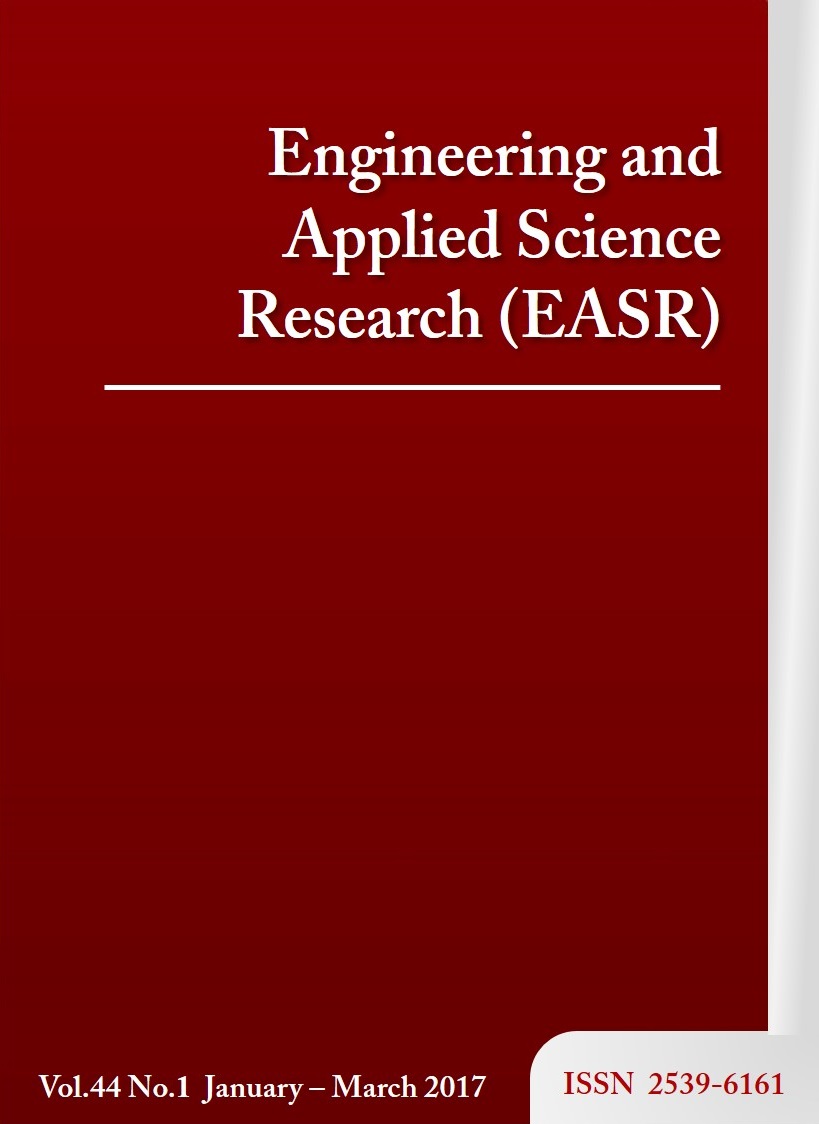Effect of pH on electrochemical treatment using platinum coated titanium mesh electrodes for post treatment of anaerobically treated sugarcane vinasses
Main Article Content
Abstract
This study examines electrochemical post treatment to remove COD, SS, K+ and Cl- from anaerobically treated sugarcane molasses vinasse (ASMV). A platinum coated titanium mesh was used as an electrode material for both the cathode and anode, with 843.18 cm2 of working area. The effects of pH on removal efficiency, as well as energy and electrode consumption, were investigated. Influent ASMV was diluted 10 times and its initial pH was adjusted by addition of HCl and NaOH. The electrolysis experiment was performed at a current density of 94.88 A/m2 with 15 minutes of reaction time, and the effluent was collected after settling for 90 minutes. The results showed that the treatment efficiency was influenced by the initial pH value. A maximal COD removal efficiency (49.25%) was obtained at a pH of 5.0. For SS removal, the maximal efficiency (46.27%) was obtained at a pH of 10.0, and the lowest level of removal occurred at neutral pH conditions. The maximal efficiency of Cl- removal (17.59%) was obtained at a pH of 8.2 (non-adjusted), and its efficiency was lower when influent was adjusted to acidic and neutral pH conditions using HCl. Maximal efficiency of K+ removal (7.23%) occurred at neutral pH conditions and did not occur at alkaline pH values. Energy consumption was lower under pH-adjusted conditions than under non-adjusted conditions, and electrode consumption was higher in both acidic and alkaline conditions relative to neutral pH conditions.
Article Details
This work is licensed under a Creative Commons Attribution-NonCommercial-NoDerivatives 4.0 International License.
References
Choeisai P. Anaerobic biodegradation of ethanol distillation plant wastewater. In: Suwannarat K, Wirojanagud W, Chaowakitchareon P, Pitayasoponkij M, Tangtrakarnpong D, Thongsanit P, editors. The proceeding of national environmental conference; 2007 March 7-9; Pitsanulok, Thailand. Thailand: Environmental Engineering Association of Thailand; 2005. p. 1-8.
Mawangnutoon N, Choeisai P, Syutsubo K. Anaerobic wastewater treatment system applied for sugarcane molasses ethanolplants in Thailand. In: Wongratanacheewin S, Tattawasart U, Punratanasin P, Nethanomsak T, editors. The proceeding of national and international graduate conference; 2016 January 15; Khon Kaen, Thailand. Khon Kaen: Graduate School, Khon Kaen University; 2016. p. 96-101.
Choeisai P, Jitkam N, Silapanoraset K, Yubolsai C, Yoochatchaval W, Yamaguchi T, et al. Sugarcane molasses-based bio-ethanol wastewater treatment by two-phase multi-staged up-flow anaerobic sludge blanket (UASB) combination with up-flow UASB and down-flow hanging sponge. Water Sci Tech. 2014; 69(6):1174-80.
Chen G. Electrocoagulation technology in wastewater treatment. Separ Purif Tech. 2004;8:11-41.
Kumar M, Ponselvan FIA, Malviya JR, Srivastava VC, Mall ID. Treatment of bio-digester effluent by electrocoagulation using iron electrodes. J Hazard Mater. 2009;165:345-52.
Tsioptsias C, Petridis D, Athanasakis N, Lemonidis I, Deligiannis A, Sanaras P. Post-treatment of molasses wastewater by electrocoagulation and process optimization through response surface analysis. J Environ Manag. 2015;164:104-13.
Krishna BM, Murthy UN, Kumar BM, Lokesh KS. Electrochemical of distillery wastewater using aluminum electrode. J Appl Electrochem. 2010;40:663-73.
Manisankar P, Rani C, Viswanathan S. Effect of halides in the electrochemical treatment of distillery effluent. Chemosphere. 2004;57:961-6.
Asaithambi P, Sajjadi B, Aziz ARA, Daud EMABW. Performance evaluation of hybrid electrocoagulation process parameters for the treatment of distillery industrial effluent. Process Saf Environ Protect. 2016;104:406-12.
Abdel Rahim MA, Hassan HB. Titanium and platinum modified titanium electrodes as catalysts for methanol electro-oxidation. Thin Solid Films. 2009;517:3362-9.
American Public Health Association/American Water Works Association/Water Environment Federation. Standard Methods for the Examination of Water and Wastewater. 18th ed. Washington DC, USA: American Public Health Association/American Water Works Association/Water Environment Federation; 1992.
Bensadok K, Hanafi NEl, Lapicque F. Electrochemical treatment of dairy effluent using combined Al and Ti/Pt electrodes system. Desalination. 2011;280: 244-51.
Zuo Q, Chen X, Li W, Chen G. Combined electrocoagulation and electroflotation for removal of fluoride from drinking water. J Hazard Mater 2008;159:452-7.



